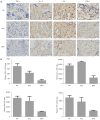Inflammation induced by lipopolysaccharide advanced androgen receptor expression and epithelial-mesenchymal transition progress in prostatitis and prostate cancer
- PMID: 34984192
- PMCID: PMC8661260
- DOI: 10.21037/tau-21-964
Inflammation induced by lipopolysaccharide advanced androgen receptor expression and epithelial-mesenchymal transition progress in prostatitis and prostate cancer
Abstract
Background: To explore the mechanism of prostatic inflammation on prostate cancer (PCa) by comparing the changes of prostate epithelial cells and PCa cells in an inflammatory environment.
Methods: First, immunohistochemistry (IHC) was used to compare the level of expression of TNF-α, IL-1β, IL-6, and TGF-β between benign prostatic hyperplasia (BPH), prostatitis, and PCa. Then primary prostate epithelial cells were sampled from patients who were suspected of PCa and had histological prostatitis (HP) confirmed by pathological biopsy. Lipopolysaccharide (LPS) or BAY11-7082 were used to investigate the change of androgen receptor (AR) and AR-mediated transcription, epithelial-mesenchymal transition (EMT) in primary prostate epithelial cells, and lymph node carcinoma of the prostate (LNCap) cells.
Results: TNF-α, IL-1β, IL-6, and TGF-β were significantly increased in HP and PCa compared with those in BPH patients. The proliferation of primary prostate epithelial cells and LNCap cells got the inflection point at LPS 10 µg/mL. In an inflammatory environment with 10 µg/mL LPS, both primary prostate epithelial cell and LNCap cell viability increased, and AR, AR-mediated transcription, and EMT processes were significantly increased. Inhibitors of NF-κB with 10 nM BAY11-7082 decreased AR, AR-mediated transcription, and EMT processes.
Conclusions: NF-κB regulates AR expression and EMT in prostatitis and PCa, and NF-κB inhibitors may have potential therapeutic value.
Keywords: Prostatitis; epithelial-mesenchymal transition (EMT); lipopolysaccharide (LPS); prostate cancer (PCa).
2021 Translational Andrology and Urology. All rights reserved.
Conflict of interest statement
Conflicts of Interest: All authors have completed the ICMJE uniform disclosure form (available at https://dx.doi.org/10.21037/tau-21-964). All authors report that this study was supported by a project grant from Shanghai Science and Technology Commission (No. 19140905402) and a project grant from Shanghai Tenth People’s Hospital (No. 04.03.20125). The authors have no other conflicts of interest to declare.
Figures







Similar articles
-
Differential research of inflammatory and related mediators in BPH, histological prostatitis and PCa.Andrologia. 2018 Feb 14. doi: 10.1111/and.12974. Online ahead of print. Andrologia. 2018. PMID: 29441606
-
Inflammatory mediators of prostate epithelial cells stimulated with Trichomonas vaginalis promote proliferative and invasive properties of prostate cancer cells.Prostate. 2019 Jul;79(10):1133-1146. doi: 10.1002/pros.23826. Epub 2019 May 2. Prostate. 2019. PMID: 31050003
-
Targeting androgen receptor to suppress macrophage-induced EMT and benign prostatic hyperplasia (BPH) development.Mol Endocrinol. 2012 Oct;26(10):1707-15. doi: 10.1210/me.2012-1079. Epub 2012 Aug 21. Mol Endocrinol. 2012. PMID: 22915828 Free PMC article.
-
The Role of Long Non-Coding RNAs in Epithelial-Mesenchymal Transition-Related Signaling Pathways in Prostate Cancer.Front Mol Biosci. 2022 Jul 18;9:939070. doi: 10.3389/fmolb.2022.939070. eCollection 2022. Front Mol Biosci. 2022. PMID: 35923466 Free PMC article. Review.
-
Interleukin-6 regulates androgen receptor activity and prostate cancer cell growth.Mol Cell Endocrinol. 2002 Nov 29;197(1-2):231-8. doi: 10.1016/s0303-7207(02)00263-0. Mol Cell Endocrinol. 2002. PMID: 12431817 Review.
Cited by
-
Plants against cancer: the immune-boosting herbal microbiome: not of the plant, but in the plant. Basic concepts, introduction, and future resource for vaccine adjuvant discovery.Front Oncol. 2023 Jul 31;13:1180084. doi: 10.3389/fonc.2023.1180084. eCollection 2023. Front Oncol. 2023. PMID: 37588095 Free PMC article. Review.
-
Research progress of extracellular vesicles in the pathogenesis of type IIIA chronic prostatitis.Front Immunol. 2025 Feb 17;16:1496055. doi: 10.3389/fimmu.2025.1496055. eCollection 2025. Front Immunol. 2025. PMID: 40034709 Free PMC article. Review.
-
Recent Advances in Transcription Factors Biomarkers and Targeted Therapies Focusing on Epithelial-Mesenchymal Transition.Cancers (Basel). 2023 Jun 25;15(13):3338. doi: 10.3390/cancers15133338. Cancers (Basel). 2023. PMID: 37444447 Free PMC article. Review.
-
Capsaicin and Cold exposure promote EMT-mediated premetastatic niche formation to facilitate colorectal cancer metastasis.J Cancer. 2024 Jan 1;15(2):356-369. doi: 10.7150/jca.83985. eCollection 2024. J Cancer. 2024. Retraction in: J Cancer. 2024 Apr 9;15(10):3151. doi: 10.7150/jca.96595. PMID: 38169517 Free PMC article. Retracted.
-
Phloretin in Benign Prostate Hyperplasia and Prostate Cancer: A Contemporary Systematic Review.Life (Basel). 2022 Jul 11;12(7):1029. doi: 10.3390/life12071029. Life (Basel). 2022. PMID: 35888117 Free PMC article. Review.
References
LinkOut - more resources
Full Text Sources
Research Materials
Miscellaneous
